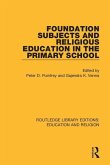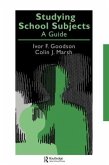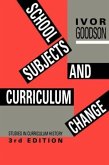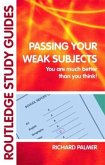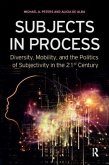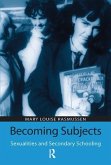Developing a Didactic Framework Across and Beyond School Subjects
Cross- and Transcurricular Teaching
Herausgeber: Klausen, Søren Harnow; Mård, Nina
Developing a Didactic Framework Across and Beyond School Subjects
Cross- and Transcurricular Teaching
Herausgeber: Klausen, Søren Harnow; Mård, Nina
- Broschiertes Buch
- Merkliste
- Auf die Merkliste
- Bewerten Bewerten
- Teilen
- Produkt teilen
- Produkterinnerung
- Produkterinnerung
Centred around a contemporary conception of Bildung, this book effectively demonstrates how the aims of cross- and transcurricular teaching can be reconciled, resulting in a didactic framework for teaching and learning in secondary schools that can be applied internationally.
Andere Kunden interessierten sich auch für
![Foundation Subjects and Religious Education in the Primary School Foundation Subjects and Religious Education in the Primary School]() Foundation Subjects and Religious Education in the Primary School35,99 €
Foundation Subjects and Religious Education in the Primary School35,99 €![Studying School Subjects Studying School Subjects]() Ivor F. GoodsonStudying School Subjects62,99 €
Ivor F. GoodsonStudying School Subjects62,99 €![School Subjects and Curriculum Change School Subjects and Curriculum Change]() Ivor F. GoodsonSchool Subjects and Curriculum Change57,99 €
Ivor F. GoodsonSchool Subjects and Curriculum Change57,99 €![Unfit Subjects Unfit Subjects]() Wanda S. PillowUnfit Subjects58,99 €
Wanda S. PillowUnfit Subjects58,99 €![Passing Your Weak Subjects Passing Your Weak Subjects]() Richard PalmerPassing Your Weak Subjects44,99 €
Richard PalmerPassing Your Weak Subjects44,99 €![Subjects in Process Subjects in Process]() Michael A. PetersSubjects in Process69,99 €
Michael A. PetersSubjects in Process69,99 €![Becoming Subjects Becoming Subjects]() Mary Louise RasmussenBecoming Subjects55,99 €
Mary Louise RasmussenBecoming Subjects55,99 €-
-
-
Centred around a contemporary conception of Bildung, this book effectively demonstrates how the aims of cross- and transcurricular teaching can be reconciled, resulting in a didactic framework for teaching and learning in secondary schools that can be applied internationally.
Produktdetails
- Produktdetails
- Verlag: Routledge
- Seitenzahl: 270
- Erscheinungstermin: 6. Mai 2025
- Englisch
- Abmessung: 234mm x 156mm x 15mm
- Gewicht: 415g
- ISBN-13: 9781032434292
- ISBN-10: 1032434295
- Artikelnr.: 73732043
- Herstellerkennzeichnung
- Libri GmbH
- Europaallee 1
- 36244 Bad Hersfeld
- gpsr@libri.de
- Verlag: Routledge
- Seitenzahl: 270
- Erscheinungstermin: 6. Mai 2025
- Englisch
- Abmessung: 234mm x 156mm x 15mm
- Gewicht: 415g
- ISBN-13: 9781032434292
- ISBN-10: 1032434295
- Artikelnr.: 73732043
- Herstellerkennzeichnung
- Libri GmbH
- Europaallee 1
- 36244 Bad Hersfeld
- gpsr@libri.de
Nina Mård is Lecturer of Education, Faculty of Education and Welfare Studies, Åbo Akademi University, Finland. Søren Harnow Klausen is Professor of Philosophy, Department of Media, Design, Education and Cognition, University of Southern Denmark, and Guest Professor in Crosscurricular Education, Åbo Akademi University, Finland.
1. Introduction
PART 1. General theory
2. Speaking and thinking about cross-curricular teaching: Terms, concepts
and conceptions
3. Rationale and aims of crosscurricular teaching and learning: For life,
knowledge, and work
4. Crosscurricular work and Bildung - Empowering the students
5. Crosscurricular teacher collaboration actualizing teacher
professionalism - revising a didactic model
PART 2. Crosscurricular teaching, thinking and competences
6. Dialogic teaching
7. Integrating movement and physical education into subject teaching:
Learning by moving
8. Fostering wellbeing competence through crosscurricular teaching:
Wellbeing and skills for life
9. Mathematics beyond and across the curriculum
10. A rhizomatic approach to arts integration in literacies and literary
education: Embracing unpredictability
11. Inspiring self-reflective dialogues through aesthetic learning
processes: Learning by drawing
PART 3. Contemporary themes calling for crosscurricular approaches
12. Analyzing domains of learning for crosscurricular teaching -
Educational crafts in focus
13. Sustainability teaching: Towards an empirically grounded model
14. Climate change as a socio-scientific issue in upper secondary
education: Addressing wicked problems through crosscurricular approaches
15. Education for democracy and democratic citizenship
16. Teaching for entrepreneurial Bildung in school
17. Language and literacy across and beyond the curriculum
18. Computational thinking beyond computer science
19. Conclusion
PART 1. General theory
2. Speaking and thinking about cross-curricular teaching: Terms, concepts
and conceptions
3. Rationale and aims of crosscurricular teaching and learning: For life,
knowledge, and work
4. Crosscurricular work and Bildung - Empowering the students
5. Crosscurricular teacher collaboration actualizing teacher
professionalism - revising a didactic model
PART 2. Crosscurricular teaching, thinking and competences
6. Dialogic teaching
7. Integrating movement and physical education into subject teaching:
Learning by moving
8. Fostering wellbeing competence through crosscurricular teaching:
Wellbeing and skills for life
9. Mathematics beyond and across the curriculum
10. A rhizomatic approach to arts integration in literacies and literary
education: Embracing unpredictability
11. Inspiring self-reflective dialogues through aesthetic learning
processes: Learning by drawing
PART 3. Contemporary themes calling for crosscurricular approaches
12. Analyzing domains of learning for crosscurricular teaching -
Educational crafts in focus
13. Sustainability teaching: Towards an empirically grounded model
14. Climate change as a socio-scientific issue in upper secondary
education: Addressing wicked problems through crosscurricular approaches
15. Education for democracy and democratic citizenship
16. Teaching for entrepreneurial Bildung in school
17. Language and literacy across and beyond the curriculum
18. Computational thinking beyond computer science
19. Conclusion
1. Introduction
PART 1. General theory
2. Speaking and thinking about cross-curricular teaching: Terms, concepts
and conceptions
3. Rationale and aims of crosscurricular teaching and learning: For life,
knowledge, and work
4. Crosscurricular work and Bildung - Empowering the students
5. Crosscurricular teacher collaboration actualizing teacher
professionalism - revising a didactic model
PART 2. Crosscurricular teaching, thinking and competences
6. Dialogic teaching
7. Integrating movement and physical education into subject teaching:
Learning by moving
8. Fostering wellbeing competence through crosscurricular teaching:
Wellbeing and skills for life
9. Mathematics beyond and across the curriculum
10. A rhizomatic approach to arts integration in literacies and literary
education: Embracing unpredictability
11. Inspiring self-reflective dialogues through aesthetic learning
processes: Learning by drawing
PART 3. Contemporary themes calling for crosscurricular approaches
12. Analyzing domains of learning for crosscurricular teaching -
Educational crafts in focus
13. Sustainability teaching: Towards an empirically grounded model
14. Climate change as a socio-scientific issue in upper secondary
education: Addressing wicked problems through crosscurricular approaches
15. Education for democracy and democratic citizenship
16. Teaching for entrepreneurial Bildung in school
17. Language and literacy across and beyond the curriculum
18. Computational thinking beyond computer science
19. Conclusion
PART 1. General theory
2. Speaking and thinking about cross-curricular teaching: Terms, concepts
and conceptions
3. Rationale and aims of crosscurricular teaching and learning: For life,
knowledge, and work
4. Crosscurricular work and Bildung - Empowering the students
5. Crosscurricular teacher collaboration actualizing teacher
professionalism - revising a didactic model
PART 2. Crosscurricular teaching, thinking and competences
6. Dialogic teaching
7. Integrating movement and physical education into subject teaching:
Learning by moving
8. Fostering wellbeing competence through crosscurricular teaching:
Wellbeing and skills for life
9. Mathematics beyond and across the curriculum
10. A rhizomatic approach to arts integration in literacies and literary
education: Embracing unpredictability
11. Inspiring self-reflective dialogues through aesthetic learning
processes: Learning by drawing
PART 3. Contemporary themes calling for crosscurricular approaches
12. Analyzing domains of learning for crosscurricular teaching -
Educational crafts in focus
13. Sustainability teaching: Towards an empirically grounded model
14. Climate change as a socio-scientific issue in upper secondary
education: Addressing wicked problems through crosscurricular approaches
15. Education for democracy and democratic citizenship
16. Teaching for entrepreneurial Bildung in school
17. Language and literacy across and beyond the curriculum
18. Computational thinking beyond computer science
19. Conclusion



